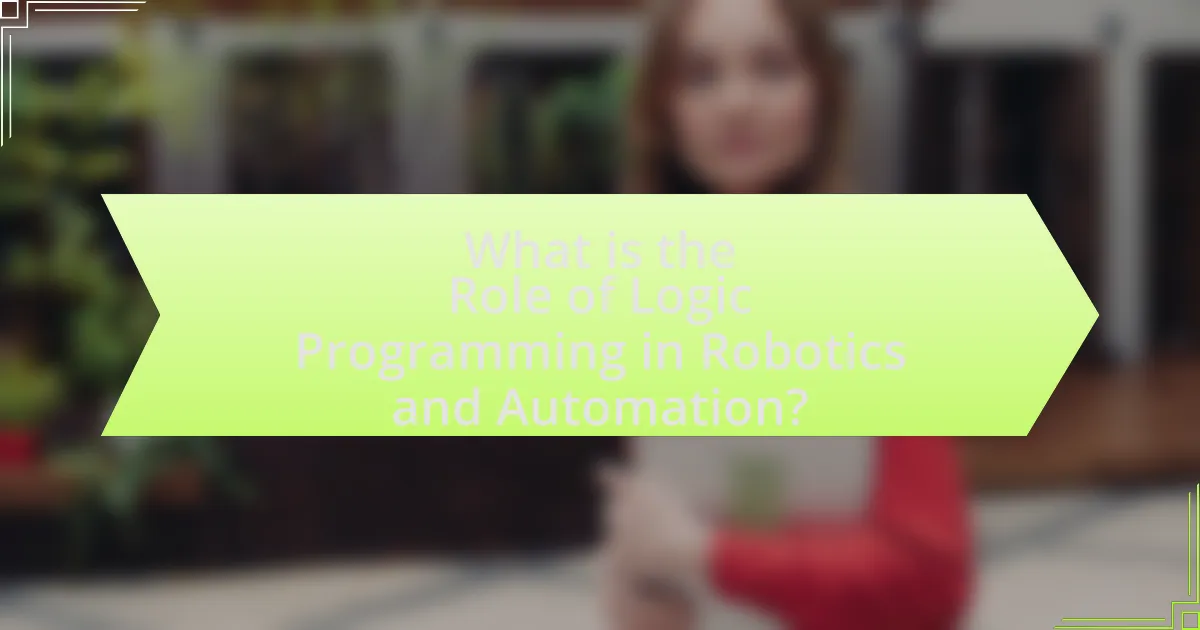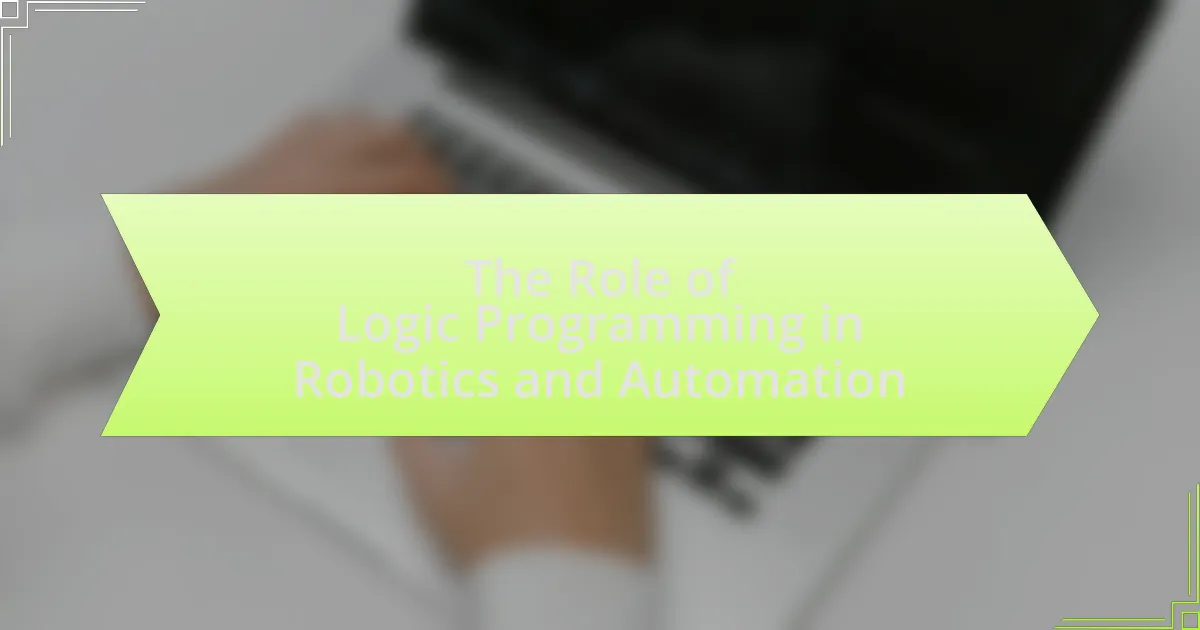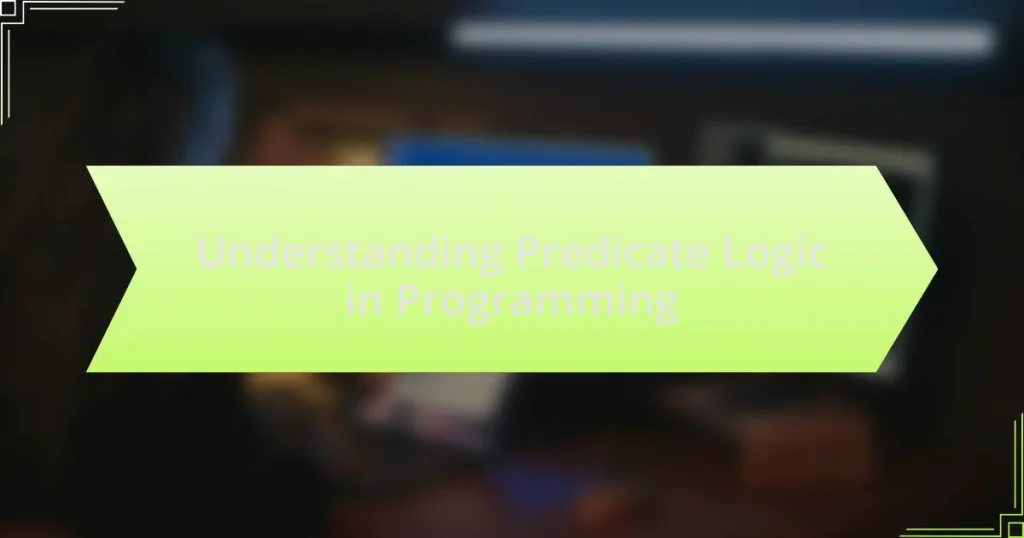Logic programming is a vital component in the fields of robotics and automation, facilitating knowledge representation and reasoning about actions through formalized logical rules. This article explores the integration of logic programming with robotic systems, highlighting its applications in automated planning, problem-solving, and robotic perception. Key principles such as declarative programming, unification, and backtracking are discussed, along with the enhancements in decision-making capabilities that logic programming provides. Additionally, the article addresses challenges faced in implementing logic programming, including computational limitations and performance issues, while also examining future advancements and best practices for effective application in robotics.

What is the Role of Logic Programming in Robotics and Automation?
Logic programming plays a crucial role in robotics and automation by enabling the representation of knowledge and reasoning about actions in a formalized manner. This programming paradigm allows robots to make decisions based on logical rules and facts, facilitating tasks such as planning, problem-solving, and learning from their environment. For instance, Prolog, a well-known logic programming language, is often used in robotic systems for tasks like pathfinding and natural language processing, demonstrating its effectiveness in managing complex decision-making processes. The ability to express relationships and constraints logically allows robots to operate autonomously and adaptively in dynamic environments, which is essential for advancements in automation technologies.
How does logic programming integrate with robotics and automation?
Logic programming integrates with robotics and automation by providing a framework for reasoning and decision-making in complex environments. This integration allows robots to process knowledge and make inferences based on logical rules, enabling them to adapt to dynamic situations. For instance, Prolog, a prominent logic programming language, is used in robotic systems for tasks such as pathfinding and problem-solving, where it can efficiently handle constraints and optimize routes. Research has shown that logic programming enhances the ability of robots to perform tasks autonomously, as evidenced by applications in automated planning and natural language processing within robotic systems.
What are the fundamental principles of logic programming in this context?
The fundamental principles of logic programming in the context of robotics and automation include declarative programming, unification, and backtracking. Declarative programming allows developers to specify what the program should accomplish without detailing how to achieve it, which is essential for complex robotic tasks. Unification is a process that enables the matching of terms and variables, facilitating reasoning about the relationships between different components in robotic systems. Backtracking provides a mechanism for exploring multiple potential solutions to a problem, allowing robots to adapt to dynamic environments. These principles are foundational for enabling robots to make decisions, solve problems, and learn from their interactions with the environment.
How does logic programming enhance decision-making in robots?
Logic programming enhances decision-making in robots by enabling them to reason about complex problems and derive conclusions from a set of rules and facts. This approach allows robots to handle uncertainty and make informed choices based on logical inference, which is crucial in dynamic environments. For instance, logic programming frameworks like Prolog facilitate the representation of knowledge and the execution of queries, allowing robots to adapt their actions based on real-time data. Empirical studies have shown that robots utilizing logic programming can improve task efficiency and accuracy, as evidenced by applications in automated planning and problem-solving scenarios.
What are the key applications of logic programming in robotics?
Key applications of logic programming in robotics include automated planning, knowledge representation, and reasoning. Automated planning utilizes logic programming to generate sequences of actions for robots to achieve specific goals, enabling efficient task execution. Knowledge representation allows robots to store and manipulate information about their environment and tasks, facilitating decision-making processes. Reasoning enables robots to infer new information from existing knowledge, enhancing their ability to adapt to dynamic environments. These applications are supported by frameworks such as Prolog, which is widely used for its expressive capabilities in representing complex relationships and rules.
How is logic programming used in robotic perception systems?
Logic programming is utilized in robotic perception systems to enable reasoning about sensory data and facilitate decision-making processes. By employing formal logic, robots can interpret and analyze information from their environment, such as visual and auditory inputs, to understand context and make informed choices. For instance, systems like Prolog allow robots to express knowledge in a declarative manner, enabling them to infer new information based on existing data. This capability is crucial for tasks such as object recognition and scene understanding, where robots must deduce relationships and properties from incomplete or ambiguous sensory inputs. The effectiveness of logic programming in these applications is evidenced by its use in various robotic platforms, enhancing their ability to operate autonomously in complex environments.
What role does logic programming play in robot learning and adaptation?
Logic programming plays a crucial role in robot learning and adaptation by enabling robots to reason about their environment and make decisions based on logical inference. This programming paradigm allows robots to represent knowledge in a formal way, facilitating the integration of new information and experiences into their existing knowledge base. For instance, logic programming can be used to define rules that govern a robot’s behavior, allowing it to adapt to changing conditions or learn from past interactions. Research has shown that systems employing logic programming can effectively handle complex tasks, such as planning and problem-solving, by leveraging logical relationships and constraints. This capability enhances a robot’s ability to learn from its environment and improve its performance over time.
What challenges does logic programming face in robotics and automation?
Logic programming faces several challenges in robotics and automation, primarily related to performance, scalability, and integration with other systems. The inherent computational complexity of logic programming can lead to inefficiencies, especially in real-time applications where quick decision-making is crucial. Additionally, as robotic systems become more complex, the need for scalable solutions increases, yet logic programming often struggles to handle large datasets and intricate problem-solving scenarios effectively. Furthermore, integrating logic programming with other programming paradigms and technologies, such as machine learning and hardware interfaces, poses significant hurdles, as these systems may not easily communicate or operate cohesively. These challenges hinder the widespread adoption of logic programming in practical robotics and automation applications.
How do computational limitations affect logic programming in robotics?
Computational limitations significantly restrict the effectiveness of logic programming in robotics by constraining the complexity of problems that can be solved. Logic programming relies on reasoning and inference, which require substantial computational resources, particularly for tasks involving large datasets or complex algorithms. For instance, robots using logic programming for navigation or decision-making may struggle to process real-time data efficiently if computational power is inadequate, leading to delays or errors in execution. This is evidenced by studies showing that robots with limited processing capabilities can only handle simpler logical constructs, thereby reducing their operational effectiveness in dynamic environments.
What are the common pitfalls in implementing logic programming in automation?
Common pitfalls in implementing logic programming in automation include complexity in rule management, performance issues, and difficulty in debugging. Complexity arises when the number of rules increases, making it challenging to maintain and understand the logic. Performance issues can occur due to inefficient rule evaluation, especially in real-time systems where speed is critical. Debugging logic programs can be difficult because traditional debugging tools may not effectively handle the non-linear execution paths typical in logic programming. These pitfalls can hinder the effectiveness of automation systems, leading to increased development time and potential system failures.
How does logic programming contribute to the future of robotics?
Logic programming significantly enhances the future of robotics by enabling more efficient problem-solving and decision-making processes. This programming paradigm allows robots to reason about their actions and environments using formal logic, which facilitates the development of intelligent systems capable of complex tasks. For instance, logic programming supports automated reasoning, allowing robots to deduce new information from existing knowledge, which is crucial for tasks such as navigation, planning, and interaction with humans. Research has shown that systems utilizing logic programming can achieve higher levels of autonomy and adaptability, as evidenced by projects like the Robot Operating System (ROS) that integrate logic-based frameworks for improved robot behavior and learning capabilities.
What advancements in logic programming are expected to impact robotics?
Advancements in logic programming expected to impact robotics include enhanced reasoning capabilities, improved knowledge representation, and better integration with machine learning techniques. These advancements enable robots to make more informed decisions based on complex data inputs and dynamic environments. For instance, the development of constraint logic programming allows robots to solve problems involving multiple constraints efficiently, which is crucial for tasks like pathfinding and resource allocation. Additionally, the integration of logic programming with probabilistic reasoning enhances robots’ ability to operate under uncertainty, as demonstrated in research by Thrun et al. (2005) on probabilistic robotics, which shows that combining these approaches leads to more robust and adaptable robotic systems.
How can logic programming evolve to meet future automation needs?
Logic programming can evolve to meet future automation needs by integrating with machine learning and enhancing its ability to handle uncertainty and dynamic environments. This evolution is essential as automation increasingly requires systems that can adapt to new data and changing conditions. For instance, combining logic programming with probabilistic reasoning allows for more robust decision-making processes in robotics, enabling machines to operate effectively in unpredictable scenarios. Research indicates that systems like Prolog can be augmented with machine learning algorithms to improve their performance in real-time applications, demonstrating the potential for this integration to address complex automation challenges.
What best practices should be followed when using logic programming in robotics?
When using logic programming in robotics, best practices include ensuring clarity in the representation of knowledge, optimizing performance through efficient algorithms, and maintaining modularity for easier debugging and updates. Clarity in knowledge representation allows for better understanding and manipulation of rules, which is crucial for effective decision-making in robotic systems. Efficient algorithms, such as those that minimize computational complexity, enhance the responsiveness of robots in real-time applications. Modularity facilitates the isolation of components, making it simpler to identify and resolve issues, as well as to integrate new functionalities. These practices are supported by successful implementations in various robotic systems, demonstrating their effectiveness in enhancing performance and reliability.
How can developers ensure effective implementation of logic programming?
Developers can ensure effective implementation of logic programming by utilizing formal methods and rigorous testing protocols. Formal methods provide a mathematical foundation for verifying the correctness of logic programs, which is crucial in robotics and automation where errors can lead to significant failures. For instance, using model checking techniques allows developers to systematically explore the state space of a program to ensure that it meets specified requirements. Additionally, employing automated testing frameworks can help identify logical inconsistencies and edge cases, thereby enhancing the reliability of the implemented logic.
What resources are available for learning about logic programming in robotics?
Resources for learning about logic programming in robotics include textbooks, online courses, and research papers. Notable textbooks such as “Logic Programming for Artificial Intelligence” by Robert Kowalski provide foundational knowledge. Online platforms like Coursera and edX offer courses specifically focused on logic programming in the context of robotics. Additionally, research papers, such as “Logic Programming in Robotics: A Survey” by Alami et al., published in the IEEE Transactions on Robotics, provide insights into current methodologies and applications. These resources collectively enhance understanding and application of logic programming in robotics.



